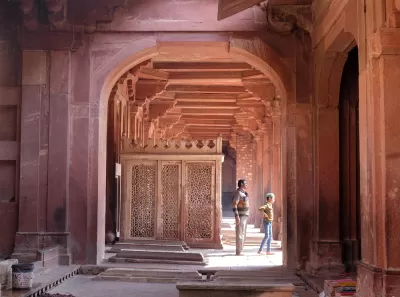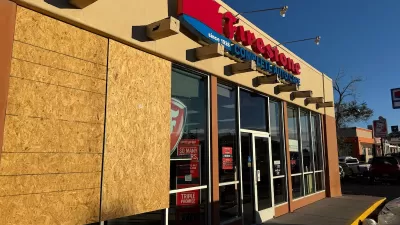Fatehpur Sikri, an example of Mughal architecture in Northern India, has some lessons and reminders for modern architects, writes Indian trained Bay Area architect, artist, and planner Ayub Patel.

On a recent trip to Northern India, Bay Area architect, artist, and planner Ayub Patel visited Fatehpur Sikri, a hilltop fortress and palace built by the Mughal Emperor Akbar the Great. Akbar was a 16th century Indian ruler from the Islamic Mughal dynasty who conquered and united far flung parts of India, including Hindu and Muslim kingdoms. Patel writes of Fatehpur Sikri:
“The drama of movement to and within the complex is heightened by shifting axes, both major and minor, coupled with the courtyard planning principles of the Persians and local Hindus. These amalgamate very well in response to both climate, privacy, and multiple vistas. As one circulates within the ensemble and it’s cleverly designed level changes, one realizes that each building within is different yet somehow extremely well connected to the rest. The ever so subtle yet powerful changes in level that separate forecourt or hind court from building or elevated plinths (that just slightly raise each building above its apron) provide boundaries of definition in a vast continuum of spatial interweave and spatial locks, allowing the onlooker to take in vistas from various vantage points. The dynamics of space within is aided by shifting axes that in some respects provide practical adjustments to the contoured terrain for each piece of the ensemble while gesturing the eye to move on to another potential vista or vantage point. Studies have revealed that the entire complex is planned with proportion based on the Golden Rectangle ratio.”
Patel concludes by quoting:
“It is the manifestation of Aldo Van Eyck’s words ‘Man, after all, breathes both in and out; when will architecture do the same?’”
For more of Patel’s words, drawings, and photos of Fatehpur Sikri, please visit the source article.
FULL STORY: A peek into the timeless past of Mughal architecture in India

Planetizen Federal Action Tracker
A weekly monitor of how Trump’s orders and actions are impacting planners and planning in America.

Restaurant Patios Were a Pandemic Win — Why Were They so Hard to Keep?
Social distancing requirements and changes in travel patterns prompted cities to pilot new uses for street and sidewalk space. Then it got complicated.

Maui's Vacation Rental Debate Turns Ugly
Verbal attacks, misinformation campaigns and fistfights plague a high-stakes debate to convert thousands of vacation rentals into long-term housing.

Boulder Eliminates Parking Minimums Citywide
Officials estimate the cost of building a single underground parking space at up to $100,000.

Orange County, Florida Adopts Largest US “Sprawl Repair” Code
The ‘Orange Code’ seeks to rectify decades of sprawl-inducing, car-oriented development.

Maui's Vacation Rental Debate Turns Ugly
Verbal attacks, misinformation campaigns and fistfights plague a high-stakes debate to convert thousands of vacation rentals into long-term housing.
Urban Design for Planners 1: Software Tools
This six-course series explores essential urban design concepts using open source software and equips planners with the tools they need to participate fully in the urban design process.
Planning for Universal Design
Learn the tools for implementing Universal Design in planning regulations.
Heyer Gruel & Associates PA
JM Goldson LLC
Custer County Colorado
City of Camden Redevelopment Agency
City of Astoria
Transportation Research & Education Center (TREC) at Portland State University
Camden Redevelopment Agency
City of Claremont
Municipality of Princeton (NJ)





























